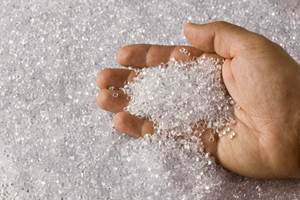Die Drawing Makes ‘Plastic Steel’From Wood-Filled PP
A developer of new plastics technologies is applying low-temperature die drawing to take advantage of a new raw material: expanded, oriented, wood-filled polypropylene (EOW-PP).
A developer of new plastics technologies is applying low-temperature die drawing to take advantage of a new raw material: expanded, oriented, wood-filled polypropylene (EOW-PP). It looks and feels almost indistinguishable from natural wood but is 150% stronger. It’s also 300% stronger than ordinary PP and close enough to the strength of steel that the term “plastic steel” is no great exaggeration.
“We haven’t been able to break it yet. It just bends,” says Frank Maine, president of SHW (Synthetic Hardwood) Technologies Inc. in Guelph, Ont., the developer of EOW-PP.
This unusual new material is made by a combination of two metalworking processes: solid-state extrusion and die drawing. Solid-state deformation processes like ram extrusion are typically used to shape high-value, non-melting plastics like UHMW polyethylene and PTFE into tubes and sheets, not to form inexpensive commodity resins. Orienting of PP film and fiber is commonplace, but orienting a solid PP profile has been limited to lab work in a few universities.
Squeeze billets into rods
In the early 1990s, researchers at the Aluminum Company of Canada Ltd. (Alcan) in Kingston, Ont., spent six years ram extruding unmelted PP into highly oriented rods of enormous strength. The process requires two steps. First, PP is extruded conventionally into billets—solid, round, or rectangular profiles that are cut to 15-20 in. lengths. The billets are then heated to slightly below the melting point and are ram extruded with a very high draw ratio into thin profiles. Haul-off tension around 450 psi keeps the profiles from relaxing before they cool.
Alcan patented the process and material but halted the project after the price of aluminum plunged. Symplastics Ltd. in Orangeville, Ont., a plastics processor already experienced in deformation processing of UHMW-PE sheet, bought Alcan’s patents and lab line and spent three more years of R&D on the process.
After three years, Symplastics’ only commercial success with the OPP profiles were small rods made for Frank Maine, who machined them into unbreakable drumsticks for musicians. “Drummers objected to the look of the plastic,” Maine recalls. “They liked the performance of the PP drumsticks, but wanted the sticks to look like wood.”
So Symplastics added 8% wood flour to the billets, which made the rods look and feel remarkably like wood. Wood-filled rods acquired less orientation but still had impressive strength. Eventually Symplastics found the R&D too costly and sold the patents and lab line to Maine, who set up SHW to try to commercialize more applications for the super-strong material.
One such application is unfilled OPP beams for automotive side-impact bars, which were tested recently side by side with steel beams. The load at failure for OPP was 30% below that of steel. But while the steel beam snapped when it failed, the OPP beam only delaminated. These preliminary test data were released earlier this month at the Society of Automotive Engineers show in Detroit by Dr. Phillip Bates, Assoc. Prof. at the Royal Military College in Kingston, Ont.
Speeding up the process
Slowness of the process was a major problem for Alcan and Symplastics. First, billets were extruded at a glacial pace of about 4 ft/hr. Adding 30% wood flour speeded up billet extrusion to about 10 ft/hr, but that still wasn’t fast enough.
The solid-state extrusion step was somewhat faster but very energy intensive. Pushing a 15-in.-long billet of 2.75-in. diam. through a compression chamber to form a 15-ft-long, oriented rod of 0.75-in. diam. took 4 min and required 3000 psi of force.
Still the process had to go faster. What Maine tried next came from his experience in die drawing of metal wire. Maine set up an experiment to see what would happen if he grabbed the front of the billet as it emerged from the die and pulled while the ram pushed. “We were told die drawing wouldn’t work with plastic, that the profile would thin out or simply break,” Maine recalls.
It didn’t. Instead, the wood-filled plastic profile held its shape and stretched. As the polymer oriented, the profile density dropped by nearly half from 1 g/cc down to 0.52 g/cc. As the polymer chains stretched, the wood fibers lined up lengthwise and pulled away slightly from the polymer, leaving tubular voids behind each fiber. These micro-voids reduced weight, increased topload strength, and imparted the look of natural wood grain.
Die drawing also went much faster—up to 30 ft/min, vs. 4 ft/min for ram extrusion alone. At such a speed, it may be possible to run billet extrusion in line with die drawing, Maine speculates. And with die drawing, Maine doesn’t need to use the ram, thereby saving energy. Pushing the billets takes 3000 psi, but die drawing takes only 1800 lb of tension to do the same work. The ram now only pushes the first 5 in. of the billet through the die, enough for the puller to grab.
Die drawing may allow larger profiles to be oriented. Ram extrusion of unfilled PP is limited to small rods, probably not over 1 in. diam., because orientation takes place only in the resin close to the compression-chamber walls. The larger the profile, the greater the ratio of weaker, unoriented core to stronger, oriented skin. Maine speculates that die drawing of wood-filled PP may cause the orientation to be more evenly distributed across the profile.
Maine says die drawing can also speed the solid-state extrusion of unfilled PP. He has not yet tested the resulting product to ascertain the level of property improvement in unfilled material.
Looking for partners
SHW’s new low-density, wood-filled composite profiles aren’t out of the lab yet. SHW is actively seeking development partners in four areas: indoor construction (chiefly flooring), outdoor construction, automotive, and defense applications. The first area to be commercialized, Maine says, will be wood-replacement products for outdoor construction.
| DIE-DRAWN OPP PROFILES WITH & WITHOUT 30% WOOD | ||
PP Wood OPP EOW-PP* | Flex. Str., psi 7000 14,000 40,000 20,000 | Flex. Mod., psi 270,000 1,300,000 1,100,000 1,100,000 |
| *Expanded, oriented, wood-filled PP. | ||
Related Content
Prices Up for PE, PP, PS, Flat for PVC, PET
Trajectory is generally flat-to-down for all commodity resins.
Read MoreFlexible-Film Processor Optimizes All-PE Food Packaging
Tobe Packaging’s breakthrough was to create its Ecolefin PE multilayer film that could be applied with a specialized barrier coating.
Read MorePrices of Volume Resins Drop by Year-End
Entering 2025, prices of major commodity and volume resins are generally in a ‘buyer’s market.’
Read MoreApril 2025: Mixed Bag for Prices of Volume Resins
The end of the first quarter marked higher prices for polyolefins and relatively flat pricing for nearly all other resins.
Read MoreRead Next
Beyond Prototypes: 8 Ways the Plastics Industry Is Using 3D Printing
Plastics processors are finding applications for 3D printing around the plant and across the supply chain. Here are 8 examples to look for at NPE2024.
Read MoreMaking the Circular Economy a Reality
Driven by brand owner demands and new worldwide legislation, the entire supply chain is working toward the shift to circularity, with some evidence the circular economy has already begun.
Read More









